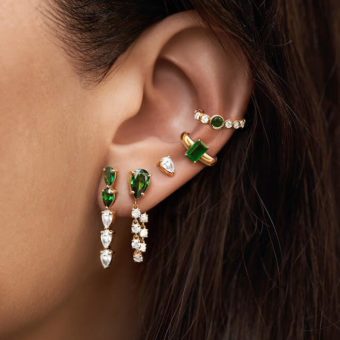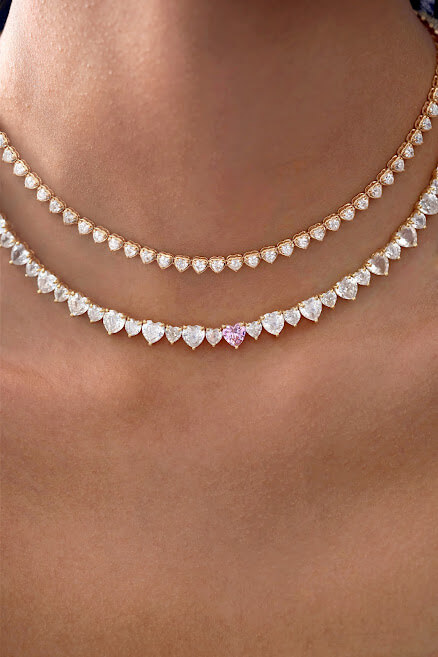You can check the authenticity of your 18K gold if it sinks in water, doesn’t attract a magnet, or has an 18K stamp. 18K means that the gold piece has a 75 per cent level of purity. But the best way to purchase real gold jewellery is through a reputable jeweller like Aquae Jewels.
You don’t have to end up with fake gold on your next jewellery purchase.
Take advantage of these gold content authentication tests to ensure you’re getting the real stuff.
The testing methods are super easy and only take a few minutes.
This post explores different ways to verify that your 18K gold is real.
Let’s get to it!

1. Skin Test
To perform this test, you need to hold the gold piece between your hands for a few minutes. If the gold is fake, it will react with the sweat from your hands and change your skin colour. Real gold will not affect your skin at all.
The contact points of the jewellery on your skin may turn blue, black, or green. Ensure you don’t wear a liquid foundation when performing this test on your skin. Real gold can react with makeup and turn your skin black at the contact points.
The test is more reliable when you rid your skin of all makeup.
But you can also use makeup to check gold authenticity.
Apply liquid foundation on your skin and add some powder over it.
Wait for the makeup to dry, then run the jewellery lightly over your skin.
If a black track appears on the makeup, the gold is real.
Real gold can only discolour your skin when your apply makeup.
Gold is a nonreactive metal. If discolourations occur during the skin test, it means the metal is an alloy of gold and other metals.
2. Magnet Test
The magnet test is another simple way to check if your gold is real. Observe how the gold piece reacts to a strong magnet placed near it. If you notice a reaction, it means you don’t have real gold.
Gold does not attract magnets. However, you should know that this test is not 100% foolproof. Your gold may be an alloy mixed with base metals that are also non-magnetic.
If the magnet test is your chosen method for verifying 18K gold, be sure to perform another more accurate method. This way, you’ll be sure of the results of your tests.
3. Stamp test
The stamp test requires you to look for markings on given gold jewellery. Real 18K gold usually comes with markings such as hallmarks, letters, or heavy gold electroplated. Look out for valid purity numbers, purity levels of 75%, and other markings that indicate different levels of quality.
Look for Hallmarks
A hallmark is a stamp engraved with a piece of gold jewellery to identify its content and/or manufacturer. Also known as the magnifying glass test, the hallmark test is an excellent way to start when checking if your 18K gold is real.
There are two standard purity scales based on karats and millesimal fineness. The valid purity number for an 18K gold is 18K in the karat system and 750 in the Millesimal Fineness system.
Anything other than the numbers above are false purity numbers.
With hallmarks, it is easier to identify and verify the authenticity of your gold piece, as it shows its level of purity.
But you need to go beyond this level of testing to confirm that your 18K gold is real, as anybody can engrave any hallmark they want.
You should know that not all genuine pieces of gold jewellery have hallmarks. If the gold piece is old, the chances are that the original markings have worn off.
Look for Letter Markings
You should also check for letter markings when verifying the authenticity of your gold piece. It is fake if the gold is less than 10k (i.e., 41.7% purity).
Here’s a list of markings to avoid when looking for real gold:
| Letter | Markings Meaning |
| GP | Gold Plated |
| GF | Gold Filled |
| GE | Gold Electroplated |
| GEP | Gold Electro Plated |
| HGP | Heavy Gold Plated |
| HEG | Heavy Gold Electroplated |
These markings indicate gold plating, which means that the piece is some other kind of metal, covered with a small percentage of gold.
Don’t allow anyone to pass off jewellery with any of these markings as 18K.
The purity level for 18K gold is 75 per cent, while that of 24K is 99.9 per cent.
There’s no such thing as 100% pure gold jewellery. Pure gold can’t make a durable piece because of its soft nature.
4. Machine Tests
You can perform machine tests using the Sigma Metalytics Precious Metal Verifier and the XRF Spectrometer. These machines send electromagnetic waves into the metal to check its authenticity.
Electronic Tester (Sigma Metalytics Machine)
The Sigma Metalytics, Precious Metal Verifier, can distinguish between metals in less than a second. This machine is calibrated on a minute scale and is perfect for measuring coins and bullion.
If you’re dealing with gold jewellery, the Kee Gold Tester stands as a better choice of machine.
The machine reads the resistance of underlying metals by sending electromagnetic waves into them.
But it’s an expensive investment if you’re only testing a few pieces of jewellery.
XRF Spectrometer
The XRF Spectrometer sends X-rays through the gold piece and excites its atoms into a higher energy state. Excited atoms give off radiation when returning to a normal state.
The radiation reading enables the machine to identify the material. If the machine detects gold content of around 75%, then your 18K gold is real.
Not only is the XRF Spectrometer is fast, but it is also safe and more performing than other machine tests.
It does not damage the material you’re testing. So, you don’t have to worry about jeopardising the value or integrity of your gold piece.
5. Ceramic Scratch Test
Scrape your 18k gold jeweller across an unglazed ceramic plate. It will leave a gold trail or mark if the gold is real. Otherwise, you will get a black mark.
You can also use a piece of tile for this method.
6. Float Test
The float test is super easy. Grab a container of water and drop the 18k gold jewellery in it. If it drops to the bottom without hovering, then the jewellery you have is probably real gold.
Gold is a dense metal. Any piece that floats in water or hovers over the bottom of the container is fake gold. However, you should know that this test is not completely foolproof.
So, ensure to perform another more accurate testing method to confirm your 18K gold.
7. Size and Weight Test
This test requires comparing your 18K gold piece with another proven 18k gold piece. All you need is a Fisch Tester or a set of callipers and a jeweller’s scale. It’s the perfect test when dealing with coins and bars.
You can tell when the 18K gold jewellery is fake if it feels too light for its size or looks too large for its Weight. Gold is heavier than most other metals. The size and weight test is an excellent way to verify your gold’s authenticity.
8. Density Test
Also known as the water test, this testing method requires you to calculate the density of the gold piece. If the figure obtained is between 12.9 and 17.7grams/litre, it could be authentic 18k gold.
You need a container of water, a scale, and a way to measure water levels in millimetres to perform this calculation.
Measure the water levels before and after putting the jewellery in the water.
Then calculate the density as follows:
Density = Weight of jewellery ÷ (After measurement – Before measurement)
The figure obtained must be close to 19.3g/mL for you to conclude that you have real gold.
It’s important to note that different types of gold have different densities. The density of the gold piece depends on how pure it is.
The purer the gold, the higher its density. Also, white gold is heavier than yellow.
Here’s an idea of what the density of different types of gold looks like:
- Gold between 14k and 22k: around 12.9 and 17.7
- Yellow gold: around 14g/mL
- White gold: 17.8g/mL.
9. Acid Tests
The acid tests include the vinegar test and nitric acid test. These tests require you to apply acid to your gold piece and check for discolouration. Real gold won’t undergo any colour change when you apply acid to it.
Here’s how to perform these acid tests:
The Vinegar Test
Apply a few drops of vinegar on the 18K gold and observe it. If a colour change occurs, then the metal is not real gold. If not, you probably have real gold.
The Nitric Acid Test
The nitric acid requires you to rub your 18K gold piece on a black stone and leave a visible mark. Once done, apply nitric acid to the mark. If the mark is still there, apply nitrohydrochloric acid.
You know the gold is real if the mark disappears after applying nitrohydrochloric acid.
Noble metals such as gold are resistant to oxidation, corrosion, and acid. The acid (nitric acid and nitrohydrochloric acid, also known as aqua regia) will dissolve any base metals that are not real gold.
10. Fail-Safe Test
The best way to confirm the authenticity of your 18K gold is by taking it to a trusted jeweller for testing. Jewellers have many different ways of checking gold content. None of the tests you can perform at home is 100% conclusive.
For that reason, it’s better to consult a jeweller for more foolproof testing.
People who try to pass lesser metals off as real gold are becoming better in their craft.
So, you need someone with experience to help you evaluate your gold.
Buy genuine 18K gold jewellery at Aquae Jewels
Some people pass lesser metals off as real gold. So, it’s wise to learn how to identify authentic gold jewellery to avoid falling into their hands.
Some of the best methods of verifying the authenticity of your 18K gold include magnet test, skin test, machine test, acid test, and more. Reputable jewellers like Aquae Jewels are a surefire way to purchase genuine gold jewellery.
At Aquae Jewels, you’ll find many high-quality, ready-to-wear, and customised 18K gold jewellery. Make your order, and we’ll deliver it in less than six days.




